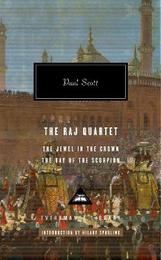
|
The Raj Quartet - Vol 1
Hardback
Main Details
Description
Volume 1 contains The Jewel in the Crown and The day of the Scorpion. Jewel in the Crown - India 1942- everything is in flux. World War II has shown that the British are not invincible and the self-rule lobby is gaining many supporters. Against this background, Daphne Manners, a young English girl, is brutally raped in the Bibighat Gardens. The racism, brutality and hatred launched upon the head of her young Indian lover echo the dreadful violence perpetrated on Daphne and reveal the desperate state of Anglo-Indian relations. The rift that will eventually prise India - the jewel in the Imperial Crown - from colonial rule is beginning to gape wide. The Day of a Scorpion - This is book two of "The Raj Quartet". India, August 9th 1942- the morning brings raids and the arrest by British police of Congress Party members. Amongst the prisoners is the distinguished ex-Chief Minister Mohammed Ali Kasim. Loyal to the party's central vision of a unified free India, his incarceration is a symptom of the growing deterioration of Anglo-Indian relations. For the long-serving British family, the Laytons, the political and social ramifications are immediate, disturbing and tragic. Some, like Ronald Merrick, believe that true intimacy between the races is impossible; others, such as Sarah Layton, struggle to come to terms with their Anglo-Indian past. With growing confusion and bewilderment, the British are forced to confront the violent and often brutal years that lie ahead of them. Paul Scott's epic study of British India in its final years has no equal. Tolstoyan in scope and Proustian in detail but completely individual in effect, it records the encounter between East and West through the experiences of a dozen people caught up in the upheavals of the Second World War and the growing campaign for Indian independence. Book one, THE JEWEL IN THE CROWN, describes the doomed love between an English girl and an Indian boy, Daphne Manners and Hari Kumar. This affair touches the lives of other characters in three subsequent books, most of them unknown to Hari and Daphne but involved in the larger social and political conflicts which destroy the lovers. On occasions unsparing in its study of personal dramas and racial differences, the RAJ QUARTET is at all times profoundly humane, not least in the author's capacity to identify with a huge range of characters. It is also illuminated by delicate social comedy and wonderful evocations of the Indian scene, all narrated in luminous prose.
Author Biography
Paul Scott (1920-1978) was born in North London, the second son of a struggling commercial artist and a mother who had burned her unpublished novels the night before her wedding. Scott's boyhood hobby of producing amateur films led him to invent dialogue - verbal images would always provide essential starting-points for his writing. Forced to leave school early and enter into a career in accountancy, he was unable to devote himself to writing until 1960. By then, he had found both his medium - the novel - and his main subject matter - India. He had been posted in India during the war, and his fascination with it never waned. Scott is mainly known today for his four inter-related novels about the events leading up to the end of the British Raj. These were published in a one-volume edition in 1976, as The Raj Quartet. In the same year, he published their coda, Staying On, and this was awarded the Booker Prize in the following year. By then, however, he was suffering from cancer, and too ill to attend the prize-giving ceremony. He died in 1978, leaving a wife and two daughters.
ReviewsNot many of E. M Forster's readers could have imagined then that his book's theme -- relations between Europeans and non-Europeans -- would soon become an acute human and literary concern. The topic has recurred often enough in fiction since then, but never, to my knowledge, has it been treated as brilliantly as it is in Paul Scott's novel, The Jewel in the Crown * The New Yorker *
|